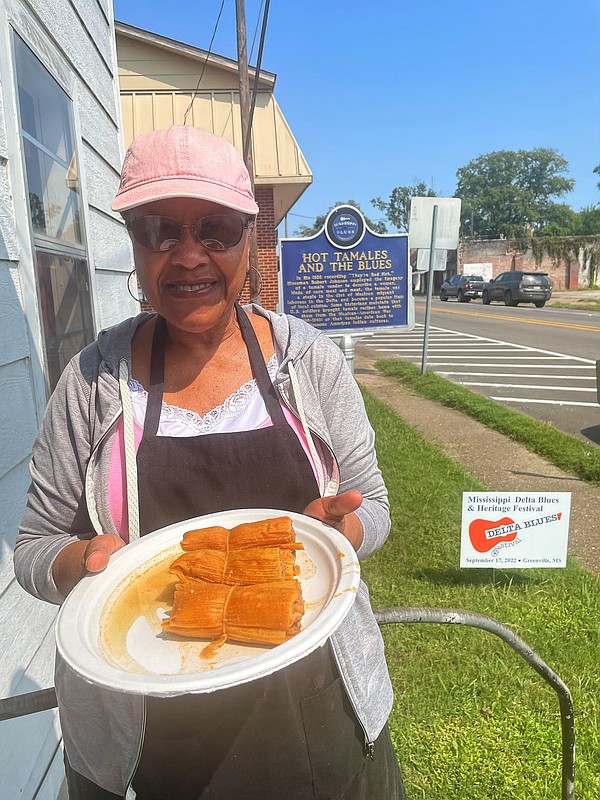Mississippi may be better known for its Delta catfish and beautiful beaches along the Gulf Coast, but there’s a trail that dissects the Magnolia State where travelers will find the history of two distinct cultures that came together in delicious fashion
While this important piece of Mississippi’s culinary history has been around for several generations, it wasn’t until the early 2000s that culinarians began giving it the love and attention it deserved, thanks to the Southern Foodways Alliance, an organization that worked with food historians and photographers to preserve the history of tamales. The Mississippi Delta Hot Tamale Trail is an offshoot of that documentation.
A BITE OUT OF HISTORY
There are several schools of thought as to how and why tamales became a ubiquitous influence on Mississippi’s food scene, one of which is that following the Mexican-American War, soldiers from Mississippi brought the idea of tamales home with them.
The most likely scenario, though, involves Mexicans who migrated north and eventually east, working alongside African Americans. As the cultures merged, so did the culinary traditions for the various foods on their tables, including tamales, a savory mix of meats and spices traditionally wrapped in corn husks for serving.
Mississippi tamales, however, are distinctly different from their south-of-the-border cousin.
“They’re smaller and spicier,” says Mary Beth Lasseter, associate director of the Southern Foodways Alliance. “The outside of a Delta tamale is made of cornmeal rather than corn flour, and they are simmered rather than steamed.”
It’s not hard to ferret out the many influences that have gone into the development of Mississippi tamales. It may not make much sense, but tamales taste different in Greenville in the Delta than they do in D’Iberville along the Gulf Coast.
Lasseter says there’s no definitive answer as to why the difference occurred, but it’s likely attributed to a combination of factors: what ingredients were readily available, the cook’s familiarity using those ingredients and personal taste and preferences.
“Pork and cornmeal commonly appeared on Mississippi tables, hence, the evolution of the recipes for Delta tamales,” she adds.
Regardless of the recipes, there’s a common connection between all tamales on the Hot Tamale Trail: They’re made with an ancestral knowledge in the same way most have been made for generations — by hand. And the best places to find them are those charming mom-and-pop eateries one finds in small towns along the trail, which stretches from the Tennessee border south to the Gulf Coast.
If you mix the correct portions of what local farmers learned to grow, hunt and cook, and add a little Mexican seasoning that found its way to this particular place in Mississippi, you end up with a plate filled with Delta deliciousness.
Add to this all the country cooking imaginable, like fried catfish, po’ boys, greens, okra and barbecue. Throw in some tamales, and you have a food culture unlike that found anywhere else.
It would take days, if not weeks, to travel the entire trail and sample each tamale, so here are some of the best places to find them in the Delta, an area of the South that holds mystery, history, beauty and flavor all its own. It’s not just the tamales that taste slightly different from each other; it’s also the sense of place and the ambiance that you’ll experience at each stop along the trail, from mom-and-pop eateries and food trucks to restaurants with more modern trappings.
Photo by Anne Braly / Kevin Smith makes tamales by hand in the kitchen at Abe’s Bar-B-Q in Clarksdale, Miss., a stop along the Mississippi Delta Hot Tamale Trail.
ROSEDALE
The road into Rosedale, Mississippi, down Highway 1 is a lonely, lovely stretch of the American South, banked by field after field of cotton ripening beneath cotton puff skies. Once inside the city limits, there’s a block of retail that’s seen better days, with ramshackle architecture and shuttered businesses.
If you’re a fan of Led Zeppelin, the name Rosedale has some significance as it’s mentioned in “Traveling Riverside Blues.” Other than that, there are just a couple of reasons to visit this small Delta town: It’s one of two locations best known as The Crossroads where Robert Johnson sold his soul to the devil in exchange for his musical talent.
But most people still come to Rosedale to get a plateful of tamales at White Front Café-Joe’s Tamale Shack. It’s a blink-twice-you’ll-miss-it kind of place — just a small, shotgun building with white siding and a historic marker in the small front yard letting visitors know they’re on the Tamale Trail.
Joe Pope opened his tamale business decades ago, and upon his death, sister Barbara Pope took over. That’s all she serves — tamales entirely made by hand and served with soda crackers. But that’s enough.
“People come here specifically to get tamales,” she says.
– On the Trail in Rosedale: White Front Café, 902 Main St.
Photo by Anne Braly / Doe’s rib-eyes come in one size — huge. Order a platter of a dozen tamales for sharing.
GREENVILLE
Greenville, Mississippi, is ground zero for tamales, with so many tamale places, it’s hard to count. There’s Perry’s Sho-Nuff where more than 200 bundles of tamales are made each week — six to a bundle.
“To make tamales, you gotta like what you’re doing,” says owner Perry Gibson.
Make sure your belt has lots of holes so you can loosen it or wear your stretchy pants and order a dozen tamales and a steak at Doe’s Eat Place — reservations strongly suggested. Doe’s is located in an old downtown neighborhood in an antiquated clapboard house with an interior that you may question, but don’t let that stop you. Doe’s steaks are legendary. And tamales? They’ve been doing them the same way going on 100 years and are different from others you’ll find along the Tamale Trail.
Doe’s has its own seasoning blend and wraps its tamales in wax paper, a process that makes a sturdier tamale that’s easier to eat. And following the waste-not-want-not philosophy, Doe’s uses steak trimmings to make its tamales, says Charles Signa, son of founder Big Doe Signa.
For a change of taste, make your way to Hot Tamale Heaven and Grille where tamales come in traditional bundles, tied and tucked in corn husks. But they’re also found in nachos, a salad, fried and served with ranch, and, a house favorite: a loaded tamale pie with layers of tamales, jalapeno peppers, homemade chili, queso cheese and a big dollop of sour cream.
There are so many tamale eateries, Greenville’s nickname is the Tamale Capital of the World and, each October celebrates with a Hot Tamale Festival. That’s just one of the festivals the town is known for. If you’re a fan of the blues, there’s the Mississippi Delta Blues & Heritage Festival that fills up most every hotel in town.
– On the Trail in Greenville: Doe’s Eat Place, 502 Nelson St.; Perry’s Sho-Nuff, 1512 U.S. Highway 82; Hot Tamale Heaven, 1427 Highway 1.
Photo by Anne Braly / Kevin Smith makes tamales by hand in the kitchen at Abe’s Bar-B-Q in Clarksdale, Miss., a stop along the Mississippi Delta Hot Tamale Trail.
CLARKSDALE
This Mississippi River town is best-known as the second place where Robert Johnson is said to have sold his soul to the devil — there are three locations around the Delta laying claim to his final resting place. But it’s No. 1 claim is that it’s the Blues Capital of America, and there’s little doubt that the claim has validity. The blues are played every night of the week in clubs around town, such as the intimate setting found at Bluesberry Café, where you can sip on a cold brew and listen to the likes of blues master Watermelon Slim.
If you stay the night in Clarksdale and want an authentic experience, book a night at Shack Up Inn. It’s a collection of restored sharecropper shacks that highlight the historic roots of the cotton industry. And just like the life of a sharecropper, luxury is not high on the list.
The morning after a night of blues demands a strong cup of coffee and a stack of blueberry pancakes at Our Grandma’s House of Pancakes.
There are several places in Clarksdale to get your tamale fix, but the one that’s been there the longest and is a stop on the Tamale Trail is Abe’s Bar-B-Q. Order a plate of mouthwatering barbecue — you’ll smell it smoking as soon as you get out of your car — along with a side of tamales, which come in bundles of three served with soda crackers and side of slaw plain or smothered with chili and cheese. Or try one of the Tamacos. It’s like a taco salad married a tamale.
– On the Tamale Trail in Clarksdale: Abe’s Bar-B-Q, 616 N. State St.
Photo by Anne Braly / Jonathan Vance, owner of Airport Grocery in Cleveland, Miss., holds a plate of tamales made using a recipe from Joe Pope, remembered as one of the best tamale makers in the Mississippi Delta.
CLEVELAND
When the Grammy Museum in Los Angeles looked to open a second, sister museum, Cleveland, Mississippi, was a natural choice with its connection to so many musicians and home to Delta State University, known for its music program. The museum is filled with Grammy history and has many interactive exhibits, including a dance floor, recording studio and touchscreens.
And a must stop for any music-history lover is Dockery Plantation, where local musicians once gathered to play, including blues legends Robert Johnson and David “Honeyboy” Edwards. Today, the farm, also known as the Birthplace of the Blues, is on the National Register of Historic Places and pays tribute to those musicians, as well as its past as one of the largest cotton farms in the Delta.
In downtown Cleveland, spend an afternoon perusing the shops along historic Cotton Row, then stop by the Cotton House Hotel, a Marriott Tribute Portfolio Hotel and its signature restaurant, Delta Meat Market, where chef Cole Ellis, a 2017 semifinalist for a regional James Beard Award, serves Delta tamales as a special several days a week and has them frozen and ready to go every day.
And at Airport Grocery, a restaurant that began life as a grocery store, the menu is filled with a variety of choices from salads to burgers, but tamales are a daily favorite the cook learned decades ago from Joe Pope of White Front Market-Joe’s Tamales Shack in Rosedale.
– On the Tamale Trail in Cleveland: Airport Grocery, 3608 Highway 61; Delta Meat Market at Cotton House Hotel, 215 Cotton Row.
Photo by Anne Braly / Tamales at Pea Soup’s Lott-a-Freeze in Indianola, Miss., are served with chili and homemade ranch dressing.
INDIANOLA
Pea Soup’s Lott-A-Freeze has been an institution in Indianola, Mississippi, for the past 55 years, serving big platters of fried shrimp dinners, Delta catfish, burgers and barbecue, but it’s the tamales that put this small diner on the map. Brenda Lott, who owns the restaurant with husband Thomas, says it’s the secret seasoning they use to simmer the tamales that makes the difference. The tamales are hand-rolled by a local tamale maker, then cooked in the seasoned simmer in the kitchen at Pea Soup’s and sold by the dozen or half-dozen.
Where else can you find them in town? Right next door at Lost Pizza, where Preston Lott — Brenda and Thomas’ son — and his partner, Brooks Roberts, sell pizza and tamales.
A trip to Indianola is not complete without a visit to the B.B. King Museum. The town is where the modern-day King of the Blues grew up, and the museum is located in an old cotton gin where the man once worked. Visitors can watch a short biographical film, then walk through the museum that will take you on a trip through American’s past of racial inequality and the life of Blacks in the South during the Jim Crow era. It will bring out myriad emotions. The self-guided tour ends at B.B.’s grave.
– On the Tamale Trail in Indianola: Pea Soup’s Lott-a-Freeze, 809 U.S. Highway 82; Lost Pizza, 807 U.S. Highway 82.
Photo by Anne Braly / If you visit Indianola, Miss., take time to visit the B.B. King Museum.
COOK WITH TAMALES
This recipe, from “Delta Hot Tamales,” by Greenville, Mississippi, native Anne Martin, is perfect for a fall gathering of friends. Find tamales locally at Abuelo’s, La Altena, Champy’s Chicken, Taqueria Jalisco Ania and other south-of-the-border eateries in town. The annual Taco Tour of restaurants on or near Rossville Boulevard can also provide ideas for authentic tamales. The recipe makes a lot, but can be easily divided for smaller crowds.
Hot Tamale Dip
2 dozen hot tamales (removed from corn shucks)
1 bunch green onions, chopped
4 cups chili, divided
3 cups grated cheese
Corn chips
Heat oven to 350 degrees. In a large bowl, mash hot tamales. Mix in green onions and 1 1/2 cups chili. In a greased 9- by 13-inch casserole dish, layer with 1/3 of the tamale mix, 1/3 of the cheese and 1/3 of the remaining chili. Repeat layers twice, ending with cheese. Bake, uncovered, for about 30 minutes or until bubbly. Serve warm with corn chips.
Contact Anne Braly at abraly@timesfreepress.com or annebraly.com.










